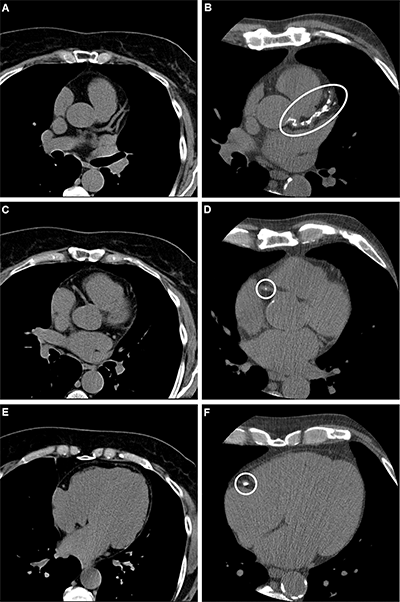Using Coronary Artery Calcium Score to Predict Patient Risk of Heart Attacks and Strokes
Findings may help patients with stable chest pain avoid invasive coronary angiography


Coronary artery calcium (CAC) scoring with CT can identify symptomatic patients with a very low risk of heart attacks or strokes, according to a new study published in Radiology. Researchers said the findings may one day help some patients with stable chest pain avoid invasive coronary angiography.
CAC scoring with CT was developed to noninvasively measure the amount of calcium in the arteries of the heart. Higher scores are linked with atherosclerosis; a score of 1 to 399, for instance, suggests a moderate amount of plaque, while 400 or higher indicates a large plaque burden.
“Coronary artery calcium is a strong and independent predictor of cardiovascular events,” said study first author Federico Biavati, an MD/PhD candidate in the BIOQIC research training group and a radiology resident at Charité – Universitätsmedizin Berlin. “The presence of coronary artery calcification indicates that atherosclerosis may have been present for some time.”
The complete absence of coronary calcifications, on the other hand, is a good indicator of the absence of advanced atherosclerosis. However, the role of CAC in patients with stable chest pain is less clear. Stable chest pain is a temporary but recurring condition triggered by stress, exercise or cold weather.
Under the direction of Marc Dewey, MD, professor and vice chair of radiology at Charité, Biavati and colleagues assessed the prognostic value of CAC scoring for major adverse cardiovascular events in 1,749 individuals, mean age 60. The participants were drawn from the DISCHARGE trial, a research project involving 26 centers in 16 European countries. Participants had stable chest pain and had been referred for invasive coronary angiography.
The researchers stratified the patients into low-, intermediate- and high-risk categories based on their CAC scores. They followed the participants for an average of 3.5 years and recorded any major adverse cardiovascular events.
People with a CAC score of zero showed very low risk of major adverse cardiovascular events at follow-up. Only four of the 755 participants in the group, or 0.5%, had a major adverse cardiovascular event during the follow-up period. The group also had a low risk of only 4.1% for obstructive coronary artery disease.
“This finding may indicate that a zero coronary artery calcium score can play a larger role in patient management strategies,” Dr. Dewey said. “The findings suggest that patients with stable chest pain and a coronary artery calcium score of zero may not require invasive coronary angiography using cardiac catheterization because the risk of cardiovascular events is so low.”

Example axial noncontrast CT scans in (A, C, E) a participant with a coronary artery calcium (CAC) score of 0, no signs of coronary artery disease at CT, and no major adverse cardiovascular events and (B, D, F) a participant who had a CAC score of 1013 (group with a CAC score of 400 or higher) and obstructive coronary artery disease at CT and required a revascularization procedure. With the scan on the left as reference, calcified plaques (ovals) can be seen on the right scan of the left main and left anterior descending arteries (proximal and mid segment, B) and the right coronary artery (proximal vessel segment, D; middle vessel segment, F).
https://pubs.rsna.org/doi/10.1148/radiol.231557 © RSNA 2024
Significantly Greater Risk Seen in Patients with Higher CAC Scores
There were 14 events in the 743 participants with a 1 to 399 coronary artery calcium score, for a risk of 1.9%. The 251 participants in the 400 and higher CAC score group had 17 events for a significantly higher risk of 6.8%. The researchers found no evidence of a difference between sexes for major adverse cardiovascular events.
Despite the findings, the researchers said that further study is needed before CAC scoring can be used to exclude patients from coronary CT angiography.
This is the second article published in Radiology from the DISCHARGE trial, the largest cardiac trial on chest pain. The first article, “Effect of Body Mass Index on Effectiveness of CT versus Invasive Coronary Angiography in Stable Chest Pain: The DISCHARGE Trial,” found that when patients suspected of having coronary artery disease were stratified by body mass index category, no differences in clinical outcomes were observed between those who underwent initial management with CT and those who underwent invasive coronary angiography.
For More Information
Access the Radiology article, “Coronary Artery Calcium Score Predicts Major Adverse Cardiovascular Events in Stable Chest Pain,” and the related editorial, "Significance of a Coronary Artery Calcium Score of 0 in Stable Chest Pain."
Access the Radiology article, “Effect of Body Mass Index on Effectiveness of CT versus Invasive Coronary Angiography in Stable Chest Pain: The DISCHARGE Trial.”
Read previous RSNA News stories about cardiac imaging:
- Photon-Counting CT Improves Coronary Artery Disease Assessment
- Assessing Radiation Exposure in the SCOT-HEART Trial
- AI Uses Body CT to Classify Multiple Diseases in Different Organ Systems